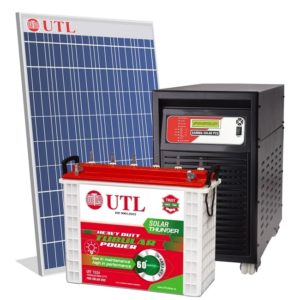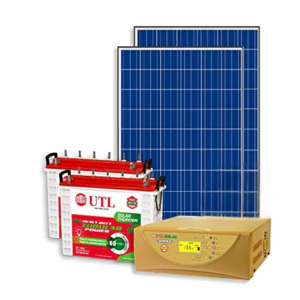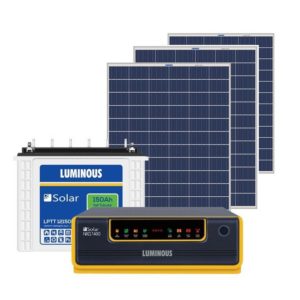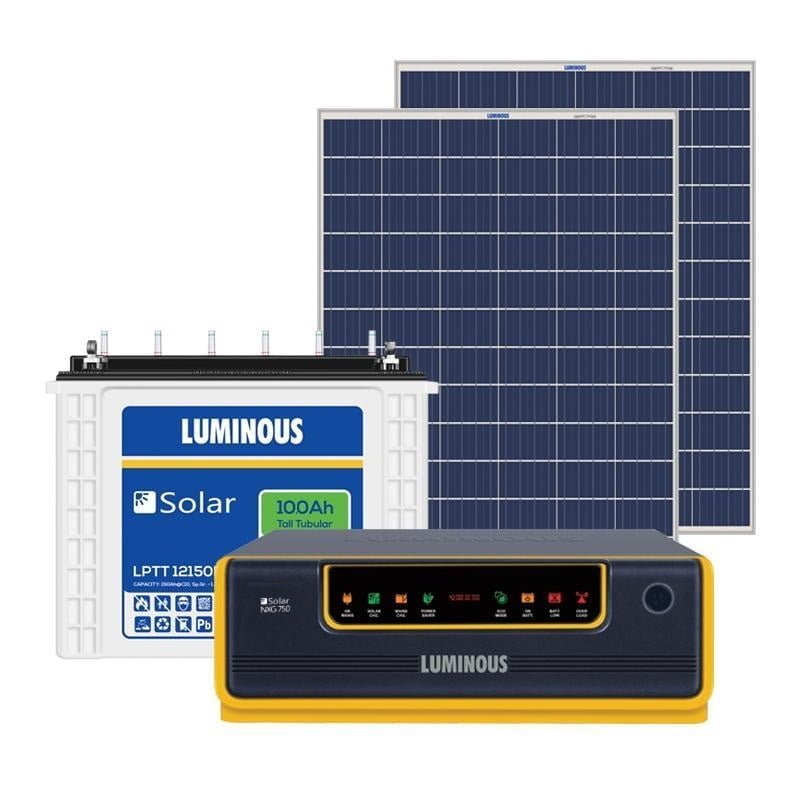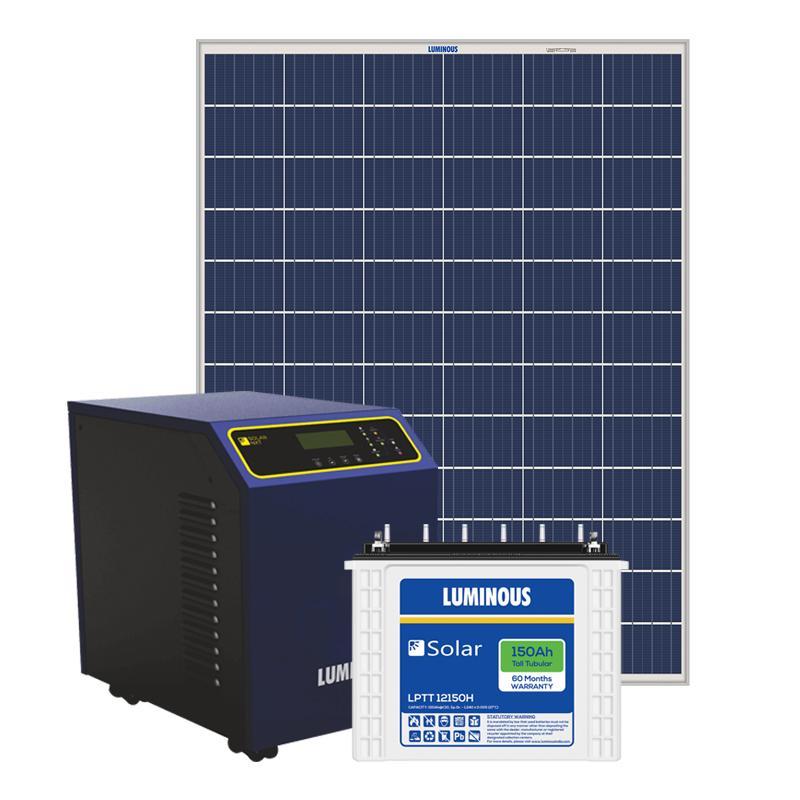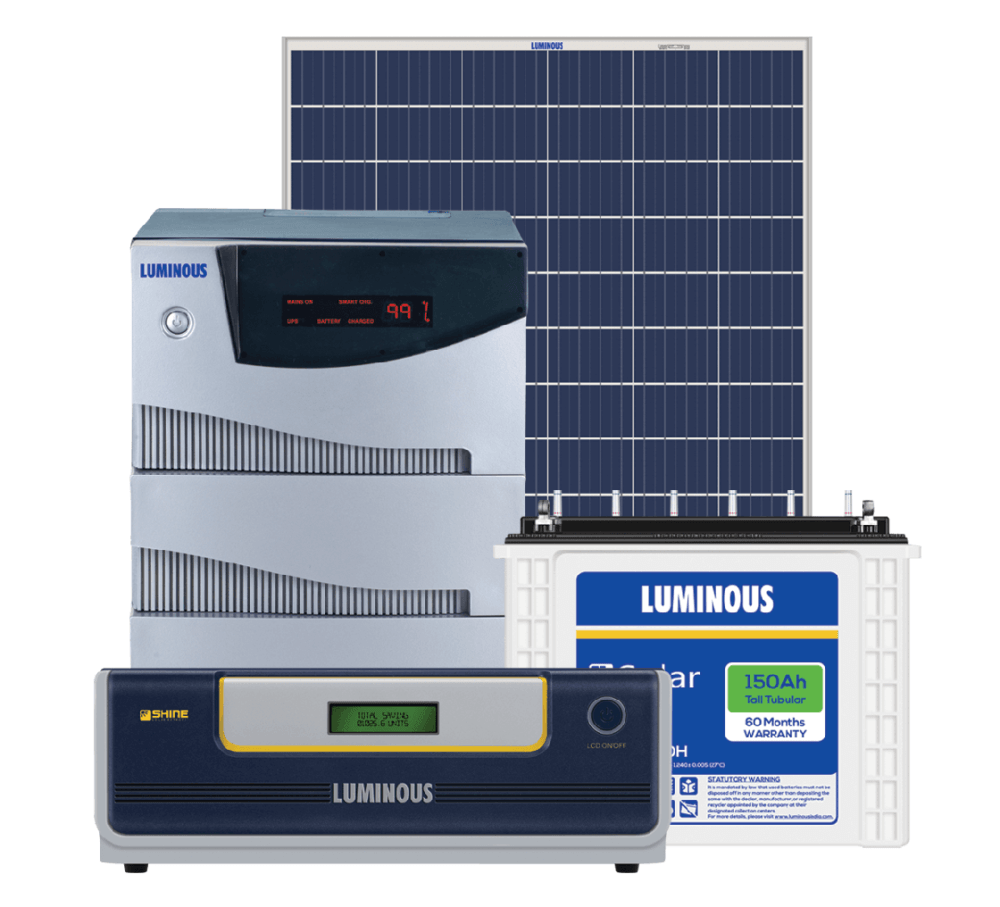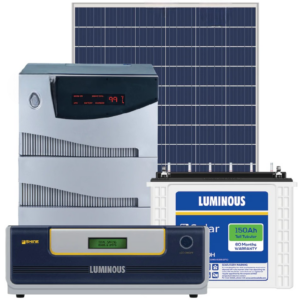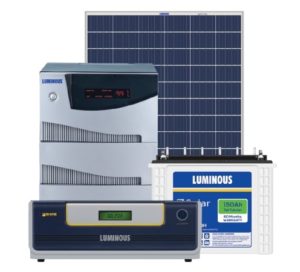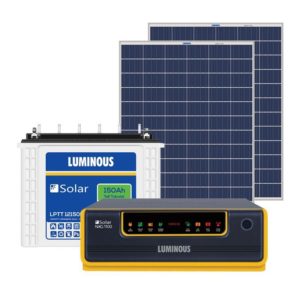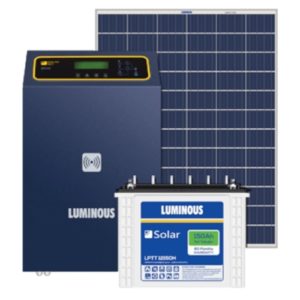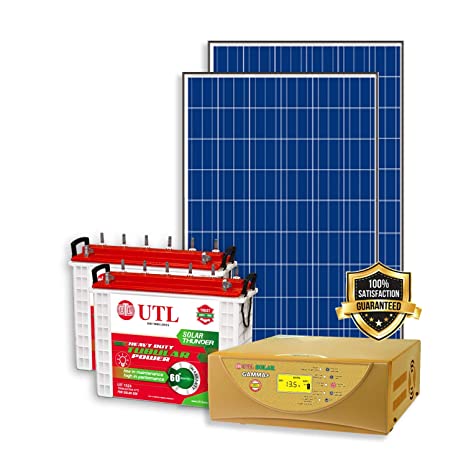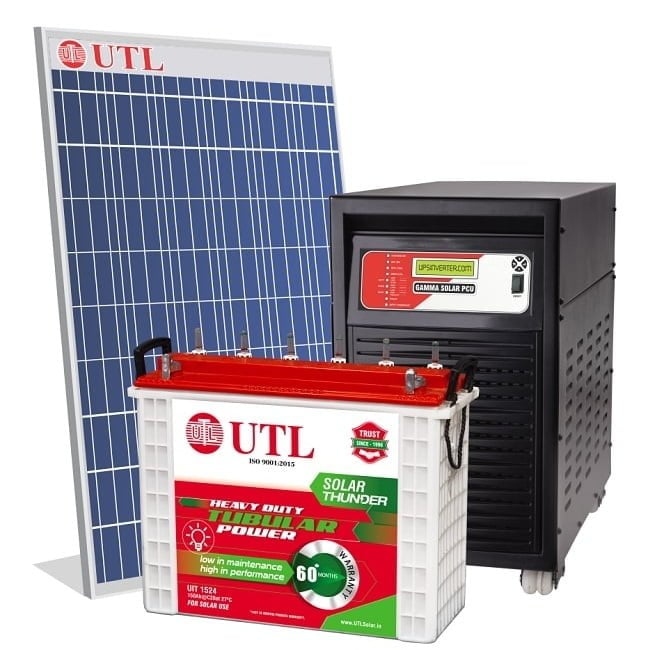Off Grid Solar System for Home with Battery Backup
The off-grid solar system is a battery based, independent solar system that does not need a utility grid to illuminate your places. It is a complete solar setup with solar panels, solar battery, and solar inverter, and is ideal to lighten a home even in a far off location. This solar system is more prominent as it comes with a power backup.
🇮🇳 हिंदी में पढ़े:

Like every other solar system, an off-grid solar system uses a solar panel to absorb sunlight and convert it into electricity. In the day time solar will run the connected load and balance energy will be stored in the solar battery. So in the daytime, the solar system runs home appliances generating electricity using sunlight and stores the extra energy into the battery bank. And at night when there is no sunlight, the appliances draw energy from the battery to keep running. Hence, the system works day and night.
Before you dive into the solar world, you must collect every single piece of information about the type of solar system to be installed. In this article, you will get answers to all your questions related to an off-grid solar system.
UTL 3kW Off Grid Solar System : Combo
UTL 2kW Off Grid Solar System : Complete
UTL 1kW Off-Grid Solar System Complete System Price
500 watt Luminous Solar System (1100VA) Price in
200 watt Luminous Complete Solar System Price(500VA)
3kW Luminous Solar System for Homes and Shops
2kW Luminous Solar System (Mppt PCU) Price in
3kW Luminous solar system for Home and Shop
2kW Luminous solar system (3.5kVA)(120AH)
3kW Luminous Solar System for Home & Business
5kW Luminous Solar System (5.5kVA) : Complete System
7.5kW Luminous Solar System : Complete Power Plant
300 watt Luminous Complete Solar System (850VA)
2kW Luminous Complete Solar System Price
10kW Luminous Solar Power System Price (Mppt PCU)
#1. Off-Grid Solar Price List
Spending money on a solar system is a one-time investment though a really huge one. If you have decided to add value to your home by installing a solar power plant, you must be aware of the price range of several solar systems.
“If you are facing power-cut problem or don’t have a reliable grid and also want to reduce your electricity bill, then off-grid solar system is recommended to you”
Off grid solar system with battery price for home starts from 1kW at Rs. 69,699 to 10kW @7 Lakh with installation of complete system. These are the complete solar combos with solar panels, solar inverter solar battery, structure, complete accessories to run your basic load of your home, business, school etc.
Solar System with Battery Price List
Here is the complete list of off-grid solar system prices. Selling prices of different capacity solar system models are mentioned against their capacities along with their solar price per watt.
| Solar System Model | Selling Price | Price/Watt |
|
1kW Solar System Price (12V) |
Rs.69,699 |
Rs.69.69 |
|
1kW Solar System Price (24V) |
Rs.83,199 |
Rs.83.19 |
|
Rs.1,61,399 |
Rs.80.69 |
|
|
Rs.2,07,499 |
Rs.69.16 |
|
|
Rs.3,52,199 |
Rs.70.43 |
|
|
6kW Solar System Price |
Rs.4,45,256 |
Rs. 74.20 |
|
7.5kW Solar System Price |
Rs.5,17,999 |
Rs. 69.07 |
|
Rs.6,41,099 |
Rs.64.11 |
- (Inclusive of all taxes) Prices can vary ± 10% to 12% depending on location, promotions and availability, and solar brand.
- Prices are exclusive of Govt. Subsidy, as the subsidy on solar systems depends on your eligibility and types of solar system.
-
Check our Online Solar Shop or Amazon Store for latest price and stock availability.
Read more about subsidy on solar here: https://kenbrooksolar.com/solar-benefits-mnre-govt-subsi
Off-Grid Solar System: Components and Working
To estimate off-grid solar system prices, you must be aware of the components the system requires to work with. You can understand the importance of each of the components only after reading about its function. The list of these components is mentioned below.
Now the question arises- how do these components work to provide constant power? The working of these components is explained clearly through the below-mentioned steps.
- The solar panels are the faces of the system that capture the sun’s energy. These devices convert the energy to DC power.
- Then comes the use of a solar charge controller. The solar panels are wired with a solar charge controller to regulate the voltage of DC generated by the solar panel. The solar inverter cum controller will monitor and measure how much energy is being produced by the solar panel array; it has the ability to harvest the maximum possible energy.
- This regulated DC gets stored in the battery bank wired with the solar charge controller. In the event of surplus availability of solar power and less load, it provides the possibility to store the energy in the battery and also cater the load simultaneously. The battery bank will allow excess solar energy to be stored and used later on when required.
- Now, this stored power can be used any time using a solar inverter to convert DC into AC to power your home appliances.
Understand Types of Solar Systems By Video
Similar YouTube Video:
Link for: Solar System For Home
Link for: On-Grid Solar System
Link for: Hybrid Solar System
#2. 1kW Off-Grid Solar System
1kW Solar System
- Free Electricity
- Power Backup
- 25 Years Warranty
- Increase Your Savings
- No Net-Metering
Specifications of 1kW Off-Grid Solar System
Each stand-alone 1kW off-grid solar system will have the following specifications.| Particulars | Description |
|
Solar System Capacity |
1kW |
|
335 Watt |
|
|
No. of Module |
3 Nos. |
|
Mono/Poly |
|
|
Efficiency |
Up to 19% |
|
Warranty |
25 Years |
| Solar Inverter | 1 kVA |
|
Inverter Type |
Off-Grid Solar Inverter |
|
Technology |
MPPT |
|
Maximum DC Input |
1 kVA |
|
Voltage |
12V |
|
Efficiency |
97% |
|
Warranty |
5 Years |
|
1 Nos. |
|
|
Technology |
Tall Tubular Solar Battery |
|
Battery Type |
C10 |
|
Capacity |
150Ah |
|
Voltage |
12V |
|
Warranty |
5 Years |
|
Other Accessories |
Junction Box, AC & DC Cable, Fasteners, Cable Tie, Crimping Tool, Earthing Kit, Lighting Arrestor |
#3. 2kW Off-Grid Solar System
2kW Solar System
- Free Electricity
- Power Backup
- 25 Years Warranty
- Increase Your Savings
- No Net-Metering
Specifications of 2kW Off-Grid Solar System
Each stand-alone 2kW off-grid solar system comes with the following ranges.|
Particulars |
Description |
|
Solar System Capacity |
2kW |
|
335 Watt |
|
|
No. of Module |
6 Nos. |
|
Mono/Poly |
|
|
Efficiency |
Up to 19% |
|
Warranty |
25 Years |
|
2 kVA |
|
|
Inverter Type |
Off-Grid Solar Inverter |
|
Technology |
MPPT |
|
Maximum DC Input |
2 kVA |
|
Voltage |
24V |
|
Efficiency |
97% |
|
Warranty |
1 Years |
|
2 Nos. |
|
|
Technology |
Tall Tubular Solar Battery |
|
Battery Type |
C10 |
|
Capacity |
150Ah |
|
Voltage |
12V (Total 24V) |
|
Warranty |
5 Years |
|
Other Accessories |
Junction Box, AC & DC Cable, Fasteners, Cable Tie, Crimping Tool, Earthing Kit, Lighting Arrestor |
#4. Off-Grid 3kW Solar System
3kW Solar System
- Free Electricity
- Power Backup
- 25 Years Warranty
- Increase Your Savings
- No Net-Metering
Specifications of 3kW Off-Grid Solar System
For buying a stand-alone 3kW off-grid solar system, you will get the following specifications.|
Particulars |
Description |
|
Solar System Capacity |
2kW |
|
335 Watt |
|
|
No. of Module |
9 Nos. |
|
Mono/Poly |
|
|
Efficiency |
Up to 19% |
|
Warranty |
25 Years |
|
3 kVA |
|
|
Inverter Type |
Off-Grid Solar Inverter |
|
Technology |
MPPT |
|
Maximum DC Input |
3 kVA |
|
Voltage |
48V |
|
Efficiency |
97% |
|
Warranty |
1 Years |
|
4 Nos. |
|
|
Technology |
Tall Tubular Solar Battery |
|
Battery Type |
C10 |
|
Capacity |
150Ah |
|
Voltage |
12V (Total 48V) |
|
Warranty |
5 Years |
|
Other Accessories |
Junction Box, AC & DC Cable, Fasteners, Cable Tie, Crimping Tool, Earthing Kit, Lighting Arrestor |
#5. 5kW Off-Grid Solar System
5kW Solar System
- Free Electricity
- Power Backup
- 25 Years Warranty
- Increase Your Savings
- No Net-Metering
Specifications of 5kW Off-Grid Solar System
Each stand-alone 5kW off-grid solar system will have the following ranges.|
Particulars |
Description |
|
Solar System Capacity |
5kW |
|
335 Watt |
|
|
No. of Module |
15 Nos. |
|
Mono/Poly |
|
|
Efficiency |
Up to 19% |
|
Warranty |
25 Years |
|
5.5 kVA |
|
|
Inverter Type |
Off-Grid Solar Inverter |
|
Technology |
MPPT |
|
Maximum DC Input |
5.5 kVA |
|
Voltage |
96V |
| Efficiency |
97% |
|
Warranty |
5 Years |
|
8 Nos. |
|
| Technology |
Tall Tubular Solar Battery |
|
Battery Type |
C10 |
|
Capacity |
150Ah |
|
Voltage |
12V (Total 96V) |
|
Warranty |
5 Years |
|
Other Accessories |
Junction Box, AC & DC Cable, Fasteners, Cable Tie, Crimping Tool, Earthing Kit, Lighting Arrestor |
#6. Off-Grid 10kW Solar System
10kW Solar System
- Free Electricity
- Power Backup
- 25 Years Warranty
- Increase Your Savings
- No Net-Metering
Specifications of 10kW Off-Grid Solar System
The following specifications are obtainable with each stand-alone 10kW off-grid solar system.|
Particulars |
Description |
|
Solar System Capacity |
10kW |
|
400 Watt |
|
|
No. of Module |
25 Nos. |
|
Mono/Poly |
|
|
Efficiency |
Up to 19% |
|
Warranty |
25 Years |
|
10 kVA |
|
|
Inverter Type |
Off-Grid Solar Inverter |
|
Technology |
MPPT |
|
Maximum DC Input |
10 kVA |
|
Voltage |
120V |
|
Efficiency |
97% |
|
Warranty |
1 Years |
|
10 Nos. |
|
|
Technology |
Tall Tubular Solar Battery |
|
Battery Type |
C10 |
|
Capacity |
150Ah |
|
Voltage |
12V (Total 120V) |
|
Warranty |
5 Years |
|
Other Accessories |
Junction Box, AC & DC Cable, Fasteners, Cable Tie, Crimping Tool, Earthing Kit, Lighting Arrestor |
Why install an off-grid solar system?
Knowing the benefits, increasing efficiency and decreasing prices, the number of people switching to the solar system, especially an off-grid solar system, is increasing extensively every day.
It is quite challenging to install utility lines while you live far away from them. Besides, it is costly and still, you cannot say much about its reliability. Moreover, you will have to pay a huge electricity bill.
On the other hand, an off-grid system is a good investment in the long run. It is efficient, reliable and environmentally friendly. It can supply sufficient power to your home without any power-cut problem. With this system, you can get non-stop solar power.
Hence, comparing these two power sources, the off-grid solar system is the obvious winner. It is the right solution for remote homeowners.
#7. Pros & Cons of Off-Grid Solar
People who believe in saving money while conserving nature find the system extremely attractive. Installing an off-grid solar system, you can decrease electricity costs to zero and avoid power outages. It eases installation at home and introduces a much better alternative power source for rural areas. Besides, it keeps the environment clean and green.
The benefits of this system are valuable enough to convince homeowners to neglect the drawbacks. Read about the pros and cons in detail and make your decision.
Pros - Advantage
- It provides you with a battery backup of 6-48 hours as per use. Since it stores electricity, you can use it anytime you want provided the battery has enough of it.
- This kind of solar system allows the customer to go off the grid. Residing in an isolated home will not bother you anymore in terms of electricity usage.
- An off-grid solar system works without an electricity grid. So, you will not have to deal with electricity bills anymore.
- A solar system installed to meet peak summer demand can power even a medium-sized air conditioning.
- Savings from the system lead to a payback period of up to 5-7 years. After that, you get free power for many more years.
- It can be installed anywhere as long as it faces the sun.
Cons - Disadvantage
- Off-grid solar systems are more expensive and less efficient than on-grid solar systems.
- No solar net metering possibilities and wastage of power if not in use and batteries are also full.
- Battery may need to replace after 5 to 7 years (Re-investment)
#8. Subsidy on Off-Grid System
The government is providing a huge subsidy on solar in order to promote solar power and bring India forward in the field of solar. You can also take advantage of this subsidy programme by installing an off-grid solar system. The subsidy rates are:
- 1kW Solar System – 3kW Solar System = 40% Subsidy
- 4kW Solar System – 10kW Solar System = 20% Subsidy
These subsidy rates may vary as per your state solar policy. Contact your state nodal agency for more info.
Expert Advice
An off-grid solar system is ideal for those who want to get rid of permanent cuts of electricity. This solar system is the ultimate solution for those who are suffering from a shortage of electricity and who do not have a reliable grid (government electricity supply). It is a self-sustainable system that ensures power supply throughout the day and at night as well.
As the name indicates, this system switches off the grid (main power grid) as a result of which you stop getting monthly electricity bills. This system allows you to live in any part of the country no matter how far it is from the power grid.
—Need a solar expert : Contact Us.
Frequently Asked Question
In an off grid solar system you can store the excess power produced by a solar panel in the solar battery. You can use the stored power at nights or when the panels are not generating the power.
It totally depends on you. You can install it on your rooftop or either you can install it on any shadow free place.
It depends upon the capacity of the solar system. By the way per kilowatt 6 sqm area is required. There are 1kW solar system, 2kW solar system, 3kW solar system and many more.
It depends on your required battery backup. For a 1kW solar system, 2 batteries of 150 AH are needed. If you want more battery backup then you need to fix more batteries otherwise vise-versa.
Battery backup time depends upon your consumption or connected load. An average battery backup of a solar battery is designed for 4-8 hours. If you are running your basic load then it provides more backup and if you are connecting your heavy load then the backup time will be reduced.
There are many reputed brands in solar like Luminous solar, Havells solar, Sukam solar and many more. All solar products of these manufacturers are best in their own way. You can choose any solar brand as per your choice.
Yes, a 30% government subsidy on panel is available in specific areas. You need to check your state solar policy for more detail.
Off-grid solar inverters are available in two technologies.
- MPPT solar inverter
- PWM solar inverter
Solar inverters in off grid systems work as conventional inverters. It is just an upgrade for solar applications.
MPPT solar inverter can produce up to 96% power while PWM solar inverters can produce only 70% of total power. So comparatively MPPT inverter is better than PWM inverter.
Solar regulator is also known as a charge controller. It is a small electronic device which controls the voltage of power, passing into the existing or non-solar battery.
In India, the optimum angle is 20-30 degrees. But it may vary according to the position of the sun from state to state.
Yes, you should buy a complete system of a single brand. Reasons: (1) You will never face issues regarding after sale service. A single company will provide you with a solar panel, inverter and battery related solution. (2) If you buy solar components from various brands then you will have to pay more GST as it is 28% on solar battery, 18% on inverter and 5% on solar panel but on complete solar system it is only 5%.
For buying the best quality off grid solar system you must contact us or you may also get it from our online store.

